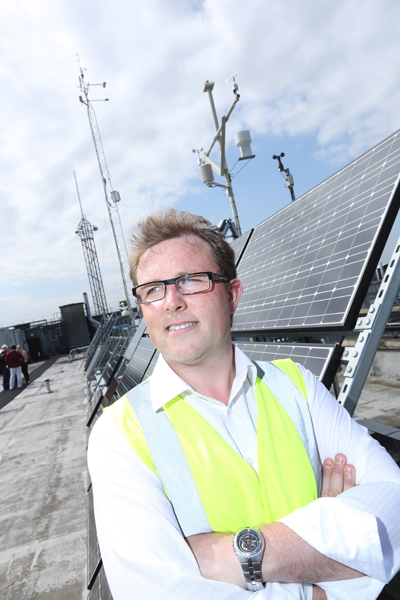Dr Rowan Fealy and Stephanie Keogh from NUI Maynooth; and Keith Sunderland, DIT
A new rooftop lab that’s poised on the roof of Dublin Institute of Technology’s (DIT’s) Kevin Street building has just been unveiled. Researchers from DIT have created the rooftop meteorological observation site to measure Dublin’s urban climatology and to connect with an international network of urban monitoring sites.
The research team behind the rooftop lab hail from the School of Electrical Engineering Systems in DIT. Researcher Keith Sunderland collaborated with his PhD supervisors (Dr Gerald Mills from UCD and Dr Michael Conlon from DIT) to create a suite of instruments that have been installed on a 10m tower on the roof of the DIT building on Kevin Street, which is in the heart of Dublin City.
So what exactly will the lab will measuring? Well, according to the researchers, it will have the scope to measure solar and terrestrial net radiation, wind velocity in three dimensions, air temperature, humidity and atmosphere concentrations of CO2 and H2O.
This installation is part of a larger urban climate research initiative that DIT is working on with Dr Rowan Fealy from NUI Maynooth and with University College Dublin. The Higher Education Authority is funding that particular collaboration.
“Right now we are working with a group of scientists from NUI Maynooth and UCD on a project that brings together research into both urban climatology and electrical engineering,” explained Sunderland, who is currently carrying out his PhD around urban wind modelling to look at the scope for connecting micro-turbines to the smart grid in city environments.
He said that this new lab is pivotal as there’s only a handful of them that currently exist around the world at the minute.
“It will provide opportunities for research interests in the broader built environment and science communities at DIT and beyond. The data collected may be used to explore other specific and general urban issues, such as wind pressures on buildings, urban planning and urban carbon footprints,” said Sunderland.

DIT researcher Keith Sunderland who led the rooftop lab project
Sunderland added that the data set also presents opportunities for linkages with urban planning bodies such as Dublin City Council. Apparently scientists and engineers are also using the rooftop at DIT to carry out research around solar photovoltaics (PV) and solar thermal technologies.
“This lab is opportunistic as it offers the full gamut of environmental research at city scale. The equipment we have up there has the potential to sample CO2 levels at 10 times a second.”
Via the outdoor lab, he said that it will open up possibilities for looking at the effect the city has on the climate.
Interestingly, he said that the DIT site is ideal for the lab as one can get a helicopter view of both the suburban and urban parts of Dublin City.
He said that the scientists and engineers working on the project would also welcome other instruments.
Health science and urbanisation across the globe
Health scientists, according to Sunderland, might also be interested in the lab to look into how the layout of cities can impact the health of city dwellers. This, he said, could be particularly relevant when city planners are mapping out green areas to absorb CO2 emissions in urban areas in the future.
And with urbanisation on the rise across the globe – more than half of the world’s population now live in cities according to the UN – perhaps such city outdoor labs will become even more vital for scientists across the world?
Between now and 2050, the UN is predicting that the world’s population will increase by 2.3bn, passing from 7.0bn to 9.3bn. It predicts that the population living in urban areas will rise by 2.6bn, passing from 3.6bn in 2011 to 6.3bn in 2050.
For instance the UN anticipates that half of the population of Asia will live in urban areas by 2020, while Africa is likely to reach a 50pc urbanisation rate in 2035.
As for urban climate, this week UCD is hosting a symposium on the urban environment.
According to DIT, delegates at the international conference will be accessing to the rooftop observation site in Kevin Street. Apparently representatives of Li-COR BioSciences, the designer and manufacturer of scientific instruments, will also be visiting the site to outline how they intend to use the outdoor scientific lab as an international benchmark for urban micro climatology and environmental observations.